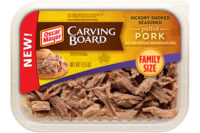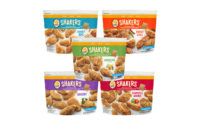Shoppers have no trouble finding reclosable packaging for products such as lunch meat, frozen fish fillets, shellfish or poultry pieces and prepared foods such as meatballs or rotisserie chicken. Reclosable packaging simplifies storage and preparation and eliminates the need to transfer multi-serving products into another container. Many designs also add tamper evidence and enhance sustainability profiles. The array of reclosable packaging choices expands on almost every shopping trip.
One new design differentiates the Simply Delicious brand of lunch meat from Land O’Frost, in Munster, Ind. The FreshSeal Attached Lid package peels open with a corner pull tab and recloses by pressing the lid back into place. The tamper-evident design eliminates the need for the primary pouch package commonly found in reclosable tubs for lunch meat. Eliminating the pouch not only represents a source reduction, but also provides better access to the product. A hinge on one side keeps the base and lid together and “prevents the lid from falling off, getting lost or landing on the floor and getting dirty,” David Van Eekeren, president and CEO of Land O’Frost, told The National Provisioner in an interview published in the August 2015 issue.
Separate friction-fit lids are a common method to reclose trays, tubs and bowls for sliced deli meat and prepared foods. Convenience and a strong potential for reuse make these containers popular with consumers, particularly when the containers are molded from dishwasher- and microwave-safe polypropylene.
Peelable/resealable lidstock serves as another reclosure option for trays, tubs and bowls. No tools are required to open the tamper-evident package the first time, and the printable lidding eliminates the need for labels and the label application operation. Relatively aggressive adhesive remains tacky during repeated openings and reclosures. The peel/reseal designs generally run on existing thermoform-fill-seal or fill-seal equipment with minimal adjustments and can be merchandised several ways: peg board, standing or flat.
For flexible packaging, favorite reclosure options include press-to-close or slider zippers and pressure-sensitive labels or flaps, which are designed to peel open and reseal multiple times. One option, compatible with modified-atmosphere packaging, features a longitudinal side seal. Peeling away a strip exposes a line of pressure-sensitive adhesive for press-and-reseal reclosure.
Pre-applied to rollstock or applied online, zipper materials can be freezer- and/or warm-temperature-tolerant. Many brand owners, including Aldi Inc., in Batavia, Ill.; Tyson Foods, Inc., in Springdale, Ark.; Jack Link’s Protein Snacks, in Minneapolis, Minn.; and Koch Foods, in Park Ridge, Ill. have embraced easy-open/reclose zipper technology to deliver convenience and functionality.
Jack Link’s, a veteran user of reclosable packaging, launched its jerky in 1994 in a reclosable pack. “We currently use Fresh-Lock [press-to-close zipper] on our jerky bags 2.25 ounces or larger,” says Brian Carter, director of research and development at Jack Link’s. With the reclosable package, he says, “Jerky lovers are able to stock up on snacks for their pantry, or buy a bag to throw in their car, gym bag, purse or elsewhere for easy on-the-go snacking that can be resealed for optimal freshness.”
Available in single- or multi-track designs, interactive zipper technology can be designed to appeal to the senses by providing consumers with audible, visual, olfactory or tactile feedback. Other innovations include material-saving designs that use less plastic in the profile and slider. Functional innovations provide better access to the product via a wider opening or a foldable zipper on the side gusset, which creates a resealable pour spout. NP





Report Abusive Comment